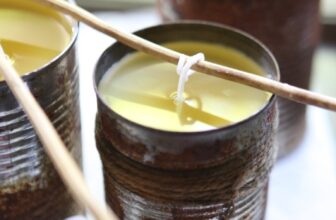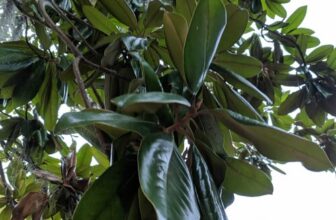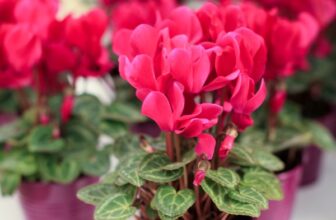If you have ever been curious about the world of handmade soap, chances are you have heard of cold process soap. This type of soap making produces an artisanal-looking handmade soap that can be scented with natural essential oils and botanical elements. Grab a few friends and learn how to make soap!
I’ve been making cold-process soap for many many years. You’ll find a gazillion soap recipes on the blog for all the soap creations I’ve made over the years. Just call me the soap lady.
Cold-process soap is part science and part art. You certainly will need to follow the step-by-step directions carefully, but if you do, you can produce the most lovely bars scented with essential oils and coloured with botanical elements.
These handmade soap bars are a project you can make at home that looks like it came from an artist’s gallery. Plus, cold-process soap has no additives that are bad for the earth, and it is gentle on sensitive skin.
If this is your first time making soap, I’ve provided plenty of detail. Once you understand the basics, you can try some of my other recipes for different variations!
Let’s get into it.
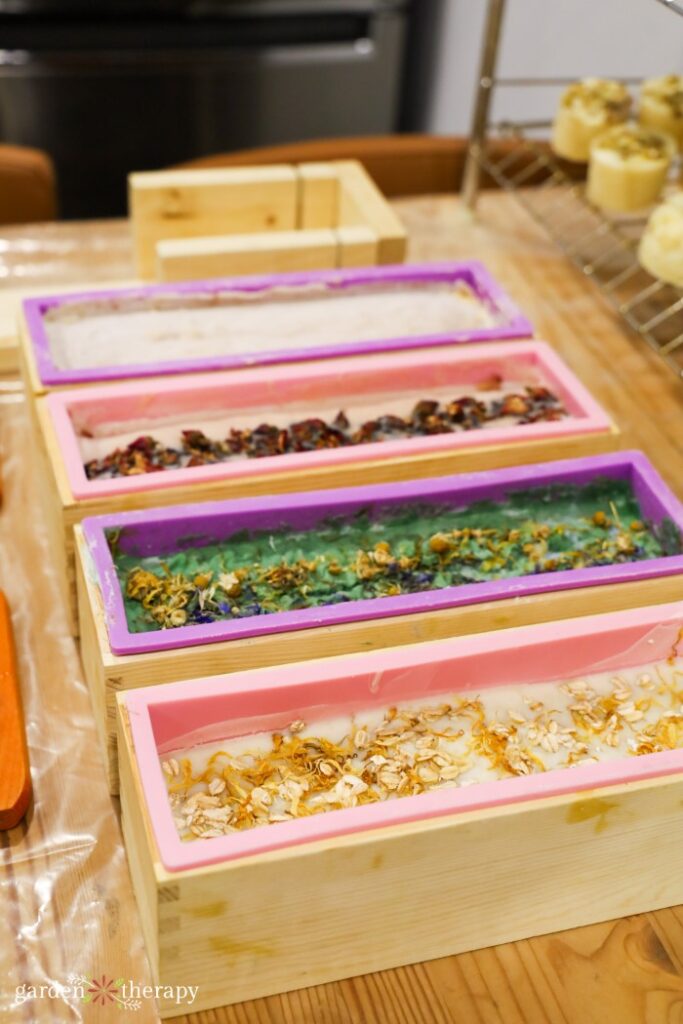
Handmade Soap Methods
Many bath and body “soaps” that are commonly sold are not actually soap. You will notice that they are called a beauty bar or body wash. These are detergents, not soap.
Real soap (such as the cold process soap in this tutorial) goes through the saponification process. This is a fancy term for converting fats, oils, lye, and water into soap and glycerin. After the chemical process has been completed, the soap is completely safe and gentle on the skin.
Even better, the glycerin coats the skin and gives skin a silky, soft feeling.
There are many methods for making handmade soap, such as melt and pour, cold process, hot process, milk soap, and rebatching.
There are pros and cons to each of these methods. I have made soap all of these ways, and each produces a very different type of soap.
Personally, I like the hot process method for making beer, wine, and tea soaps. I melt and pour for quickly making fun, decorative soaps, which you can see some examples of in my melt and pour soap idea book, Good Clean Fun.
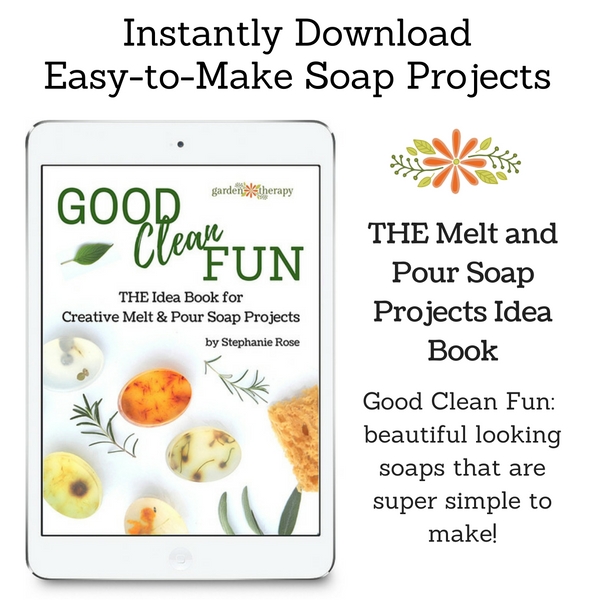
Safety When Soapmaking
It’s best to wear protection when making soap, as lye can burn your skin. Until the oils and lye have turned into soap (48 hours after making the recipe), it’s best to protect yourself. Always wear rubber gloves, safety goggles, and keep your work area free from kids and pets.
At the same time, don’t let this intimidate you. While safety is important, you should have no issues working with the lye if you follow precautions properly.
How to Make Cold Process Soap
I like cold-process soap the most as my everyday soap. I usually make soap in big batches every year, so I have plenty to choose from throughout the year and plenty more to give away.
Cold-process soap makes a wonderful gift for yourself and others, but it does require following the instructions to the letter. If you are a first-time soap maker, partner with a friend and make handmade soap together—it helps to have a buddy system, and it’s a lot of fun!
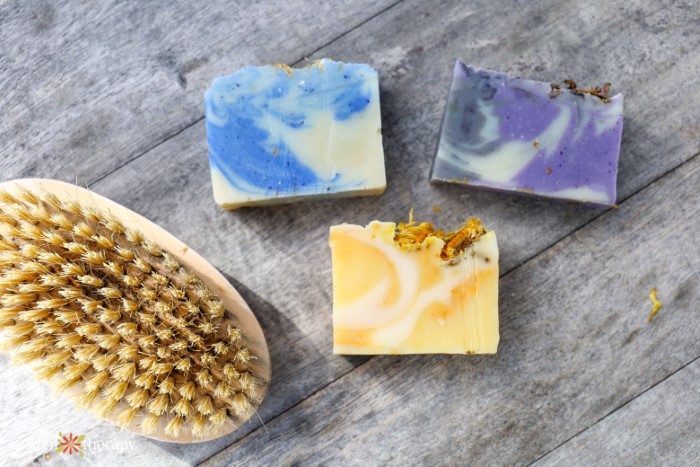
Ingredients for Cold Process Soap
All cold-process soap will have fats and lye ingredients. This is the core of what makes soap, well, soap! Once you have a basic recipe down, you can start adding different types of oils and butters, as well as fragrances, colours, and other additives.
If you’re a beginner, start with a basic soap-making recipe such as this moisturizing olive oil soap.
Mix temp 115°F
Oils
Lye mixture
Step-by-Step Soap Making Instructions
Weigh Ingredients
If you are not using a kit, the first and most crucial step in cold-process soap making is to weigh the raw ingredients (fats, lye, water) precisely. Prep everything that you will need and lay it out accessibly before you begin.
Soapmaking measurements are done in weight, not volume, so be sure to get a good kitchen scale and weigh out the ingredients.

Heat the Oils
Gently (slowly) heat oils in a stainless steel pot on the stove. Alternatively, use a microwave and heat for two minutes on high, and then at shorter intervals until you reach the temperature listed in the recipe.

Prepare Lye Ingredients
Make sure you have your safety gear on, as we’re starting to work with the lye.
Using room-temperature distilled water, weigh the amount specified by the formula into a heat-resistant glass bowl or large Pyrex measuring cup. While stirring, slowly add the measured amount of lye. I repeat, SLOWLY.
It’s important to note that you add the lye to the water, not the water to the lye.
Stir until dissolved. This mixture will get super hot quickly, so be mindful of that. Also, the fumes are terrible, so if you can stir from below the fumes (with lye on the counter and you crouching below as you stir) outdoors or at least with windows open, that would be best.
Place the glass container in an ice-water bath and cool to the required temperature. For this basic recipe, it’s 115 degrees. Get accurate temperature readings with a candy thermometer in the middle of the solution.
When both oils and lye/water are at the required temperatures (as stated in your recipe), slowly pour lye/water into the oils while rapidly stirring in small circles. Always add lye/water to oil, not the other way around.

Thicken the Mixture
Continue to rapidly stir the mixture until it thickens to the consistency of pudding (called “tracing”). The mixture is ready to be moulded when a drizzle mark from the spatula remains for a few seconds on the top of the mixture.
Speed up the tracing process by using a hand blender to mix. Be careful not to overmix, as the mixture becomes difficult to put correctly in the mould.
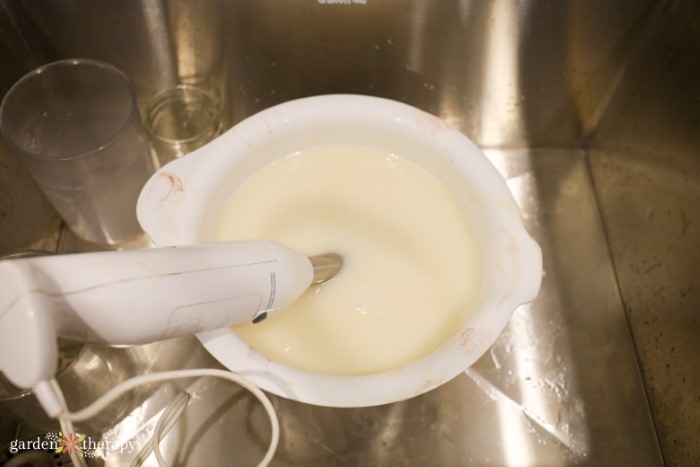
Add Essential Oils and Colourants
Add essential oils, natural colourants, and herbs or exfoliants at this stage (see recipes below). Work fast, as the mixture will quickly start to thicken.
There are many options for colouring and scenting soap, but I avoid perfumes, fragrances, and artificial colours. I like handmade natural soap scented with pure essential oils and coloured with natural dyes.
Pour into Mould
As someone who has been soapmaking for years, I use 42 oz soap moulds and they make things super simple.
For a beginner, you can also use milk cartons. Pour mixture into 1L milk cartons and staple the tops shut.
Wrap the mould (or cartons) in a large towel and set it somewhere warm for 48 hours, like the top of the fridge. The moulds will feel warm and will get hot as the mixture neutralizes and turns into soap.
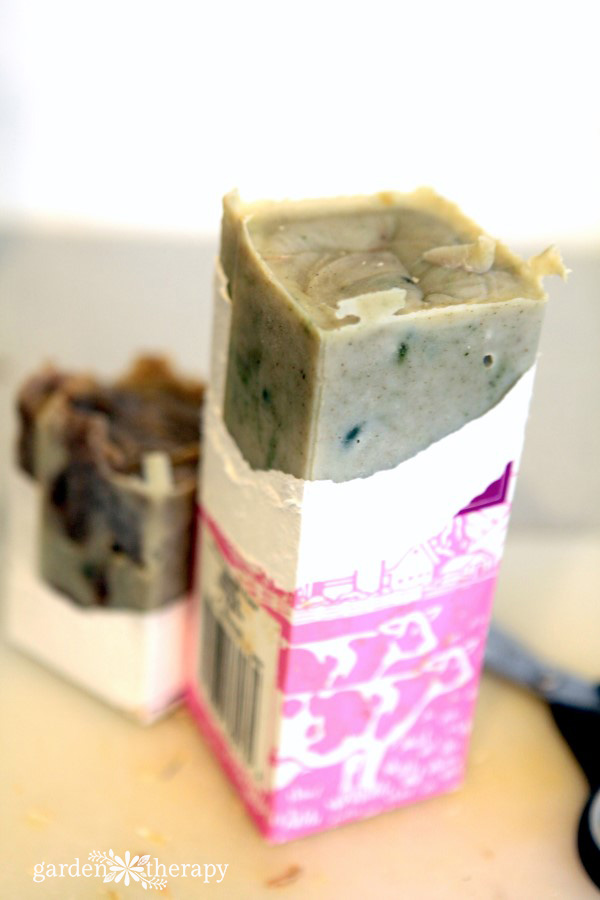
Unmould and Cut
For my moulds, it’s easy to remove the inner silicone and flip the soap out. I then cut the soap into equal pieces.
To unmould your soap in cartons, peel off the milk cartons and cut each full 1-litre carton lengthwise into 3 equal sections for shower soap, and 4 equal sections for hand soap. Flip each section so that it appears to be a square from the top, and cut into 3 equal sections.

Cure
Place each bar on a wire rack in a cool, dark place to cure for six weeks. After six weeks, the soap can be buffed with a cotton cloth and wrapped for gifts.
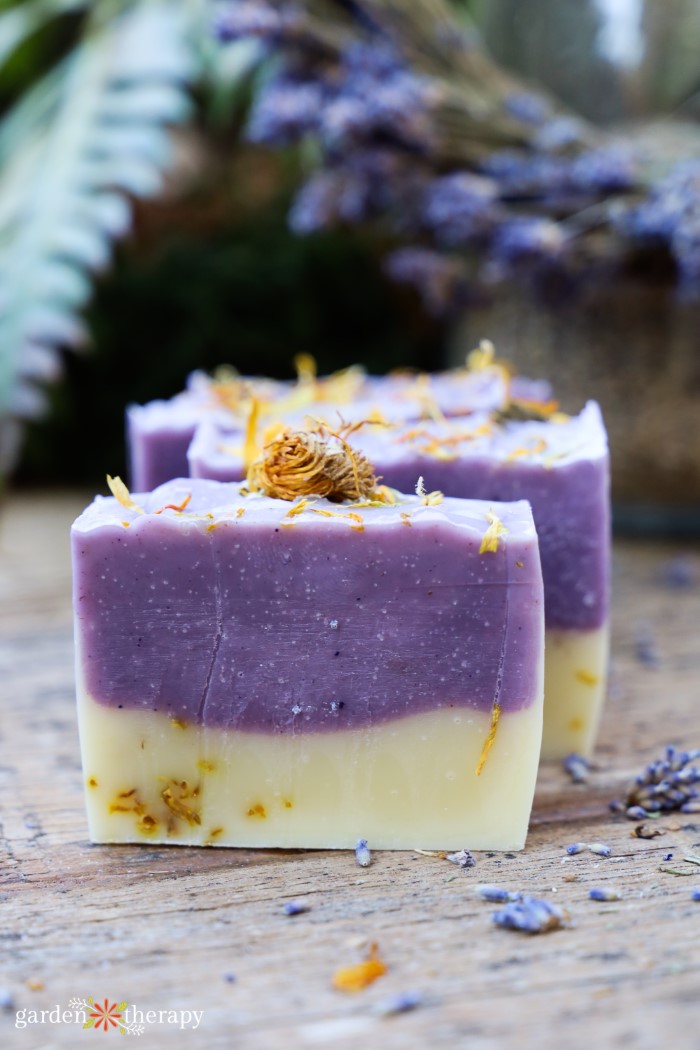
Simple Cold Process Soap Recipe to Try
Once you master the basic recipe, you will discover that it’s incredibly versatile! Here are just a few ways you can “dress up” cold-process soap. All are made with natural vegetable ingredients, pure essential oils, natural colours, and herbs from the garden. You can feel good about taking care of those who use your handmade soap.
Lemongrass, Ginger, and Coffee Kitchen Soap
- Add 1 tablespoon of dry, finely ground coffee at trace
- Scent with 15ml lemongrass and 5ml ginger essential oils
- Colour with turmeric
To get the two-toned look in this soap, I filled half of the milk carton with one colour and topped it with another. This makes each of the bars unique. The purple in the above soap was lavender-scented soap coloured with ratan jot and mixed with dried lavender buds.

Rosemary and Spearmint Energizing Shower Soap
To get the two-toned look in this soap, I filled half of the milk carton with one colour and topped it with another. This makes each of the bars unique.
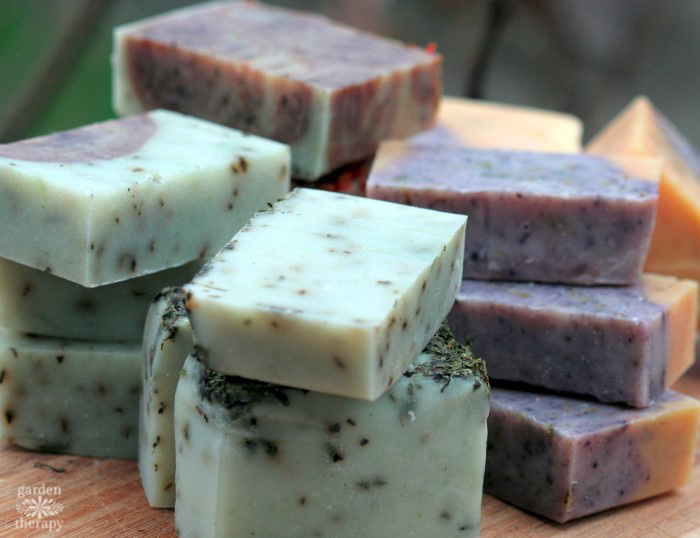
Orange Vanilla Cinnamon Soap

Even More Handmade Soap Recipes to Try
As I said above, you can just call me the soap lady. Here are some of my cold process handmade soap recipes. Hopefully, one of them calls your name!
Cold Process Soap FAQ
There are many different methods that people use, but I have a technique I like to use often called the 3-point swirl. I add the colours in the bowl itself, adding the mica powder (or other colourant) to the side of the bowl. I mix it in place and use a spatula to drag the colour through the mix only once.
Most of the swirling happens when you pour the soap into the mould itself. Once poured, I use a chopstick and swirl a figure eight pattern through the soap once. And that’s it!
For more details on this method, check out this post.
Traditionally, soap was made using oil or fat and combining it with white wood ash that was turned into lye water. Now, things are much easier, and we can just use caustic soda instead of wood ash, which is sold as pellets, flakes, or powder. There are so many more optional ingredients that are often found in homemade soap, which I have detailed here.
If you’re a certified shower gel person, the switch to bar soap can be confusing. To use bar soap, you’ll want to get the bar wet and work it in your hands for fifteen seconds until it creates a lather. You can then apply the bar of soap directly to your skin or use a loofah to help lather and exfoliate.
If you want to avoid using lye, the best method is to try out melt-and-pour soap instead. This is when you melt down an existing soap base and add your own additives, such as colours and scents, and pour them into your own moulds. Find more info about melt and pour and recipes to try.
How to Make Cold Process Soap
This handmade soap recipe will show you exactly how to make a batch of cold process soap at home.
Lye Materials
- 78 grams sodium hydroxide (NaOH)
- 215 grams filtered/distilled water room temperature
-
Weigh and measure every ingredient ahead of time. It is imperative that items are weighted and measured precisely.
-
Wear gloves and safety goggles, and keep your workspace clean – lye can burn skin.
-
Heat the oil ingredients slowly in a stainless steel pot until you reach a temperature of 115 degrees.
-
Pour the room-temperature water into a large pyrex measuring cup. Stir, and SLOWLY add the pre-weighed lye. It’s important to note that you will add lye to the water, not the other way around.
-
Stir until dissolved. Then place the glass container in an ice bath and cool to 115 degrees.
-
When the oils and lye mixtures are both at 115 degrees, slowly pour the lye into the oil mixture while rapidly stirring in circles.
-
Stir until the mixture becomes thick, and similar to the texture of pudding.
-
Add in the botanicals and/or essential oils – see the blog post for ideas.
-
Pour the mixture into moulds (I use 1L milk cartons), and staple the tops shut. Then, wrap the moulds in a towel and set on top of the fridge for 48 hours.
-
Unmould the soap and cut into even sections. Then, place the bars on a wire rack and let them cure for 6 weeks.
-
Buff with a cotton cloth, and wrap to give as gifts or use yourself!
A city girl who learned to garden and it changed everything. Author, artist, Master Gardener. Better living through plants.


